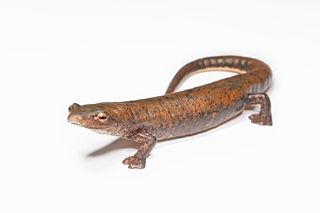The Millville climbing salamander is a species of salamander in the family Plethodontidae. It is endemic to Costa Rica. Its natural habitat is subtropical or tropical moist montane forests. It is threatened by habitat loss.

The La Loma salamander is a species of salamander in the family Plethodontidae. It is found in Costa Rica and western Panama. The common name refers to La Loma, its type locality on the trail between Chiriquicito and Boquete, earlier in the Bocas del Toro Province but at present in the Ngäbe-Buglé Comarca, Panama. Its natural habitats are humid lowland and montane forests. It is largely an arboreal species living in bromeliads, but it can be found on the ground too. It is threatened by habitat loss.
The Cerro Pando salamander is a species of salamander in the family Plethodontidae. It is found in Costa Rica and Panama. Its natural habitat is subtropical or tropical moist montane forests. It is threatened by habitat loss.
The Quebrada Valverde salamander is a species of salamander in the family Plethodontidae. It is endemic to Costa Rica. Its natural habitat is subtropical or tropical moist montane forests.
The Tapanti climbing salamander is a species of salamander in the family Plethodontidae, the salamander is endemic to Costa Rica. Its natural habitats are subtropical or tropical, moist lowland forests and subtropical or tropical, moist montane forests. Currently the species is under threat due to habitat loss.
The Rio Quiri salamander is a species of salamander in the family Plethodontidae. It is endemic to Costa Rica. Its natural habitat is subtropical or tropical moist montane forests. It is threatened by habitat loss.

The Camron climbing salamander, also known as the Camron mushroomtongue salamander or wood colored salamander, is a species of salamander in the family Plethodontidae. It is found in Costa Rica and Panama. Its natural habitat is subtropical or tropical moist lowland forests. It is threatened by habitat loss.
The crater salamander, also known as the marbled crater salamander, is a species of salamander in the family Plethodontidae. It is endemic to Costa Rica and Panama. Its natural habitat is subtropical, high-altitude moist montane forests. It has a small area of distribution and is threatened by habitat loss therein.
The dwarf climbing salamander is a species of salamander in the family Plethodontidae. It is found in Costa Rica and Panama. Its natural habitat is subtropical or tropical moist montane forests. It is threatened by habitat loss.
The Cordillera Central salamander is a species of salamander in the family Plethodontidae.
The Tapantí giant salamander is a species of salamander in the family Plethodontidae. It is endemic to Costa Rica. Its natural habitat is subtropical or tropical moist montane forests.
Bolitoglossa pesrubra is a species of salamander in the family Plethodontidae. It is endemic to Cordillera de Talamanca, Costa Rica.
The robust climbing salamander is a species of salamander in the family Plethodontidae. It is found in Costa Rica and Panama. Its natural habitats are subtropical or tropical moist lowland forests and subtropical or tropical moist montane forests. It is threatened by habitat loss.

The Cocle salamander, also known as the Cocle mushroomtongue salamander, is a species of salamander in the family Plethodontidae. It is found in Costa Rica and Panama. In Costa Rica, it is only known from the southeastern part of the country on the Atlantic versant, whereas in Panama it is more widespread and occurs also on the Pacific versant. Its natural habitats are humid lowland and montane forests. It is a common species in Panama, whereas it is only known from a single specimen in Costa Rica. It is threatened by habitat loss.
The shadowy web-footed salamander is a species of salamander in the family Plethodontidae. It is found in Costa Rica and possibly Panama. Its natural habitat is subtropical or tropical moist montane forests. It is threatened by habitat loss.
The Cordillera Talamanca salamander is a species of salamander in the family Plethodontidae. It is found in Costa Rica and possibly Panama. Its natural habitat is subtropical or tropical moist montane forests. It is threatened by habitat loss.
The Cukra climbing salamander is a species of salamander in the family Plethodontidae. It is found in Costa Rica, Honduras, and Nicaragua. Its natural habitats are subtropical or tropical moist lowland forests, subtropical or tropical moist montane forests, freshwater marshes, and plantations . It is threatened by habitat loss.
The La Palma salamander is a species of salamander in the family Plethodontidae. It is found in Costa Rica and western Panama.
Gomez's web-footed salamander is a species of salamander in the family Plethodontidae. It is found in Costa Rica and Panama. Its natural habitat is subtropical or tropical moist lowland forests.
The Tico salamander is a species of salamander in the family Plethodontidae. It is native to Costa Rica.




